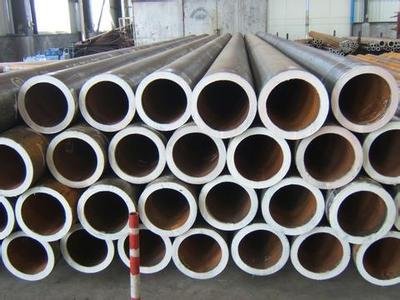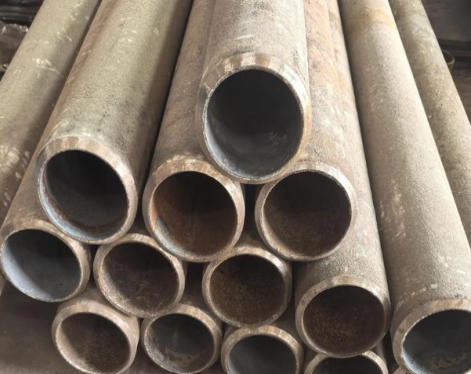The cutting or separation of steel pipes(welded steel tube or seamless pipe) is an important part of forming. Commonly used methods include mechanical cutting, punching and laser cutting. Laser cutting is the use of focused high-power-density laser beams to irradiate pipes, so that the irradiated materials are rapidly melted, vaporized, ablated or reach the ignition point. At the same time, the molten material is blown away by the high-speed airflow coaxial with the beam, so as to realize the cutting of the steel pipe. Laser cutting is one of the thermal cutting methods.
Stainless steel pipes below 4mm can be cut with laser cutting equipment, and carbon steel pipes with a thickness of 20mm can be cut by adding oxygen to the laser beam, but a thin oxide film will be formed on the cutting surface after cutting with oxygen. The maximum thickness of the cutting can be increased to 20mm, but the size error of the cutting parts is large.

Features of laser cutting
⑴ good cutting quality
Due to the small laser spot, high energy density and fast cutting speed, laser cutting can obtain better cutting quality.
① The laser cutting slit is thin and narrow, the two sides of the slit are parallel and perpendicular to the surface, and the dimensional accuracy of the cut parts can reach ±0.05mm.
② The cutting surface is smooth and beautiful, and the surface roughness is only tens of microns. Even laser cutting can be used as the last process without machining, and the parts can be used directly.
③ After the steel pipe is laser cut, the width of the heat-affected zone is very small, and the properties of the material near the cutting seam are hardly affected. Moreover, the deformation of the steel pipe is small, the cutting precision is high, the geometric shape of the slit is good, and the cross-sectional shape of the slit presents a relatively regular rectangle.
⑵ High cutting efficiency
Due to the transmission characteristics of the laser, the laser cutting machine is generally equipped with multiple CNC workbenches, and the entire cutting process can be fully numerically controlled. During operation, only need to change the CNC program, it can be applied to the cutting of parts of different shapes, both two-dimensional cutting and three-dimensional cutting can be realized.
⑶ Fast cutting speed
Using a laser with a power of 1200W to cut a 2mm thick low carbon steel pipe, the cutting speed can reach 600cm/min; cutting a 5mm thick polypropylene resin pipe, the cutting speed can reach 1200cm/min. The material does not need to be clamped and fixed during laser cutting, which not only saves tooling fixtures, but also saves auxiliary time for loading and unloading.
⑷ Non-contact cutting
There is no contact between the torch and the steel pipe during laser cutting, and there is no tool wear. To process parts of different shapes, there is no need to change the "tool", only the output parameters of the laser need to be changed. The laser cutting process has low noise, little vibration and no pollution.
⑸ Many types of cutting materials
There are many types of laser cutting materials, including metal, non-metal, metal-based and non-metal-based composite materials, leather, wood and fiber. However, for different materials, due to their own thermal physical properties and different absorption rates of laser light, they show different laser cutting adaptability.
⑹ Disadvantages
Due to the limitation of laser power and equipment volume, laser cutting can only cut medium and small thickness plates and pipes, and as the thickness of the pipe increases, the cutting speed decreases significantly. The cost of laser cutting equipment is high, and the one-time investment is large.
Stainless steel pipes below 4mm can be cut with laser cutting equipment, and carbon steel pipes with a thickness of 20mm can be cut by adding oxygen to the laser beam, but a thin oxide film will be formed on the cutting surface after cutting with oxygen. The maximum thickness of the cutting can be increased to 20mm, but the size error of the cutting parts is large.

Features of laser cutting
⑴ good cutting quality
Due to the small laser spot, high energy density and fast cutting speed, laser cutting can obtain better cutting quality.
① The laser cutting slit is thin and narrow, the two sides of the slit are parallel and perpendicular to the surface, and the dimensional accuracy of the cut parts can reach ±0.05mm.
② The cutting surface is smooth and beautiful, and the surface roughness is only tens of microns. Even laser cutting can be used as the last process without machining, and the parts can be used directly.
③ After the steel pipe is laser cut, the width of the heat-affected zone is very small, and the properties of the material near the cutting seam are hardly affected. Moreover, the deformation of the steel pipe is small, the cutting precision is high, the geometric shape of the slit is good, and the cross-sectional shape of the slit presents a relatively regular rectangle.
⑵ High cutting efficiency
Due to the transmission characteristics of the laser, the laser cutting machine is generally equipped with multiple CNC workbenches, and the entire cutting process can be fully numerically controlled. During operation, only need to change the CNC program, it can be applied to the cutting of parts of different shapes, both two-dimensional cutting and three-dimensional cutting can be realized.
⑶ Fast cutting speed
Using a laser with a power of 1200W to cut a 2mm thick low carbon steel pipe, the cutting speed can reach 600cm/min; cutting a 5mm thick polypropylene resin pipe, the cutting speed can reach 1200cm/min. The material does not need to be clamped and fixed during laser cutting, which not only saves tooling fixtures, but also saves auxiliary time for loading and unloading.
⑷ Non-contact cutting
There is no contact between the torch and the steel pipe during laser cutting, and there is no tool wear. To process parts of different shapes, there is no need to change the "tool", only the output parameters of the laser need to be changed. The laser cutting process has low noise, little vibration and no pollution.
⑸ Many types of cutting materials
There are many types of laser cutting materials, including metal, non-metal, metal-based and non-metal-based composite materials, leather, wood and fiber. However, for different materials, due to their own thermal physical properties and different absorption rates of laser light, they show different laser cutting adaptability.
⑹ Disadvantages
Due to the limitation of laser power and equipment volume, laser cutting can only cut medium and small thickness plates and pipes, and as the thickness of the pipe increases, the cutting speed decreases significantly. The cost of laser cutting equipment is high, and the one-time investment is large.
Previous:Quenching method









